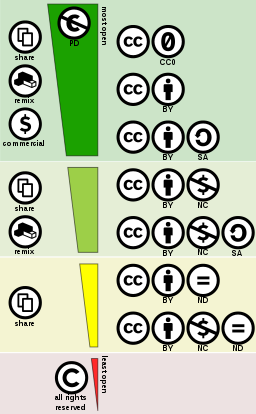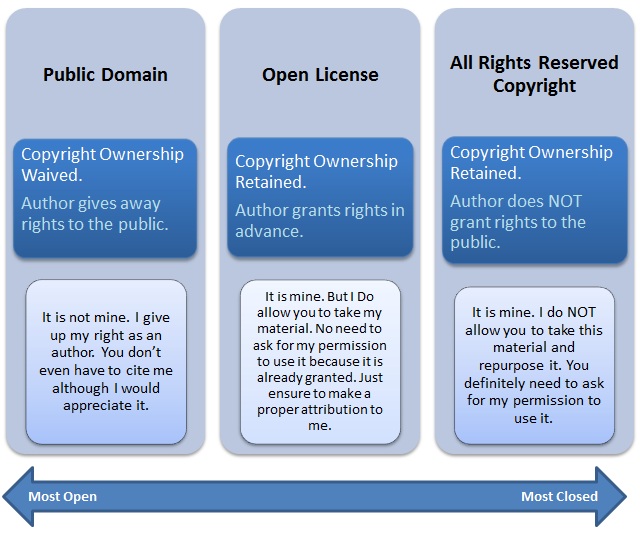3 Introduction to Open Licensing
Learning Objectives
This chapter will support learners in being able to:
- Define an open license
- Distinguish between materials that are all rights reserved, in the public domain, and openly licensed
- Identify the four factors of fair use
What is Copyright?
Copyright is a form of legal protection automatically provided to the authors of “original works of authorship,” including literary, dramatic, musical, and artistic works. Copyright in the U.S. is automatically assigned to creators of work, with no registration necessary.
It can be unlawful to use copyrighted works of others without their permission, and no permissions are granted in the case of All Rights Reserved (ARR) works. Activities such as copying, modifying, publicly displaying, publicly performing, and distributing copies of ARR work may be illegal unless permission is granted by the creator. U.S. copyright law generally gives the author/creator or owner of an original creative work an exclusive right to
- Reproduce (copy) or distribute the original work to the public (e.g., create and sell copies of a film)
- Create new works based upon the original work (e.g., make a movie based on a book)
- Perform or display the work publicly (e.g., perform a play)
Violation of one of these rights is called copyright infringement. However, the use may be authorized by copyright limitations (such as fair use) described below.
What is Fair Use?
Start with an overview of fair use by viewing this short video:
Fair use is a copyright principle based on the belief that the public is entitled to freely use portions of copyrighted materials for purposes of commentary and criticism. Whether or not a specific use falls under Fair Use is determined by four factors:
- the purpose and character of your use
- the nature of the copyrighted work
- the amount and substantiality of the portion taken, and
- the effect of the use upon the potential market
Unfortunately, if the copyright owner disagrees with your fair use interpretation, the dispute may have to be resolved by a lawsuit or arbitration. If it’s not a fair use, then you are infringing upon the rights of the copyright owner and you may be putting yourself or the institution at risk. The only guidance for fair use is provided by a set of factors outlined in copyright law. These factors are weighed in each case to determine whether a use qualifies as a fair use.
Understanding the distinctions between the reuse and sharing of copyrighted material versus openly licensed or public domain material is essential for a thorough comprehension of the Fair Use principle.
Additional information on Fair Use and the TEACH Act can be found at the University of Texas Libraries – Crash Course on Copyright website.
Understanding an Open License
In Module 1 you learned that an open educational resource is either in the public domain or released with copyright permissions which allows for free use and repurposing by others. Specifically, an open license exists as a way for the original creator to clearly inform others how their work can be used by granting permissions to share and adapt their work. A Public Domain license and the variety of open license permissions known as Creative Commons (CC) are the predominant standards for open licenses. You will learn more about the six different CC license permissions in Chapter 8.
This video, What Is An Open License and How Does it Work?, provides more information about the benefits of an open license and how this standard makes sharing and reusing resources easy.
Why is an Open License Important?
It is the copyright status and license applied to a work which determine what you can and cannot do with the creative work of someone else. Knowing how to identify and differentiate between common types of copyright status will be useful when determining which content you may reuse, and how. One should assume that a work is all rights reserved, unless the creator explicitly states otherwise or the user of the work can prove it differently.
As you search for OER, you will become familiar with the markings of each copyright type.

What is the Public Domain?
A public domain work is a creative work that is not protected by copyright, which means it’s free for you to use without permission. Works in the public domain are those for which intellectual property rights have expired, have been forfeited, or are inapplicable.
Here are some examples of works in the public domain:
- Material created by the US Government, such as pictures taken by NASA
- Materials for which Copyright Protection has lapsed, such as “New Hampshire” by Robert Frost
- Works released to the public domain when they were created, such as images on Pexels
Determining if a work is in the public domain can be difficult because the terms of copyright protection in the United States have changed over time. The Cornell University Library Copyright Information Center is a useful tool for understanding what works might fall into the public domain.
What is the Difference Between Public Domain and Open License?
They both grant free access to the materials, but the scope and nature are completely different.
Open licensing does recognize clear ownership of intellectual property and the work is still protected under copyright law, whereas works in the public domain are not protected by copyright law. Therefore, users are required to follow the license requirements when using openly licensed materials.
This infographic illustrates the differences between public domain, open license, and all rights reserved copyright.

Why Open Licensing Matters
The power of open licensing lies in its ability to clearly communicate how the creator intends the work to be used. A creator can explicitly share the work and control the licensing provisions while retaining ownership. Remember, for a work without a copyright notice, all rights reserved is assumed. So if you want to openly share your OER with your students and faculty peers, or publish it online for the world to access, displaying an open copyright license statement with the work ensures it will be easily and clearly adopted in the way you intend.
In Chapter 8 you will spend more time learning about the permissions behind the six different Creative Commons Licenses. In that module, you will focus on distinguishing between the different permissions for adoption, adaptation, creation, attribution, and reuse. This module serves as an introduction and overview of copyright, fair use, public domain, and open licenses.
Concept Review
Fill in the blanks below using terms from the following list: copyright, copyleft, creative commons, public domain, permissions, attribution, fair use, openly licenses
To complete the Module 3 Final Activity (the next step in earning OCO’s OER 101 badge), return to OER 101 Module 3.

